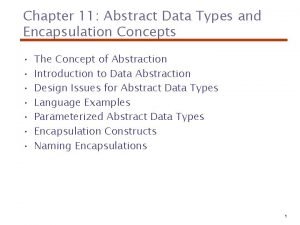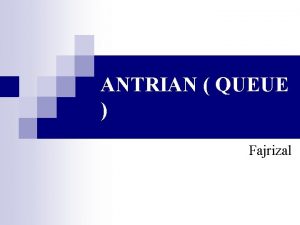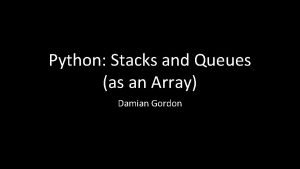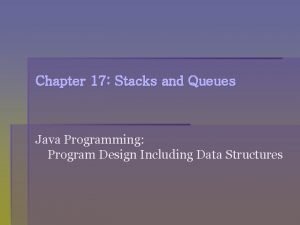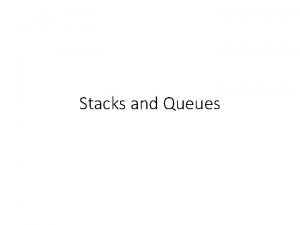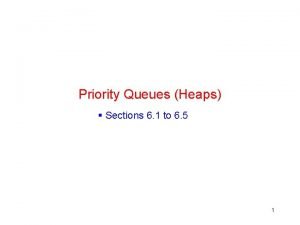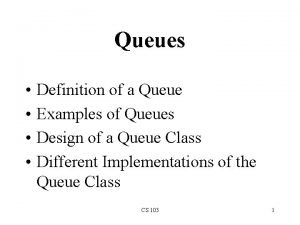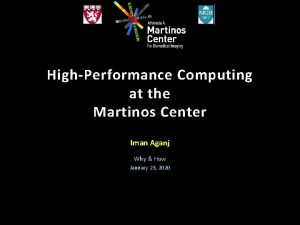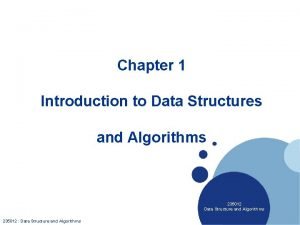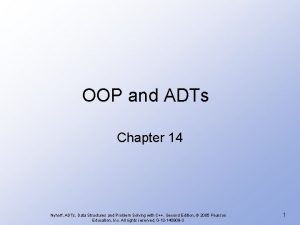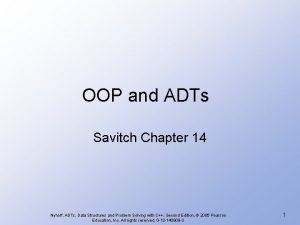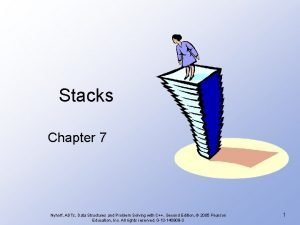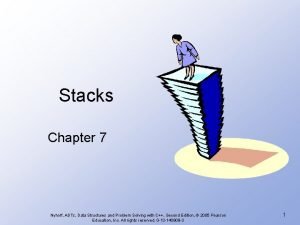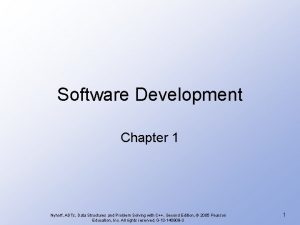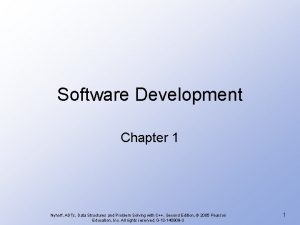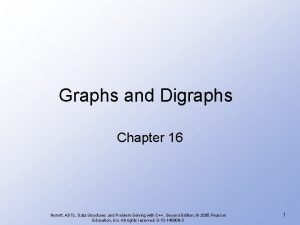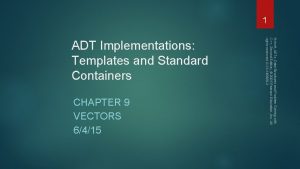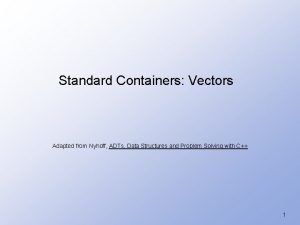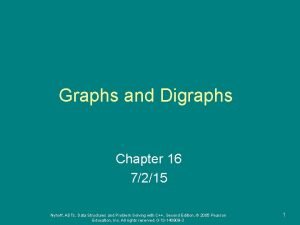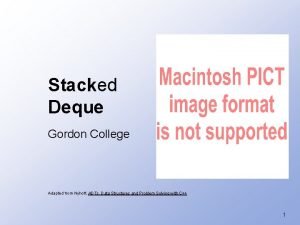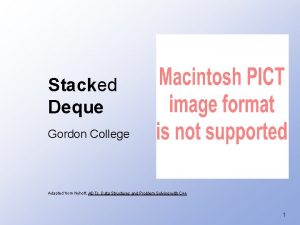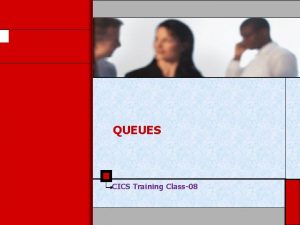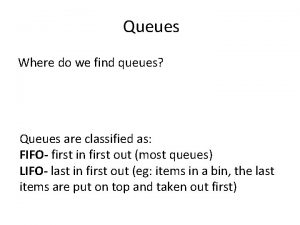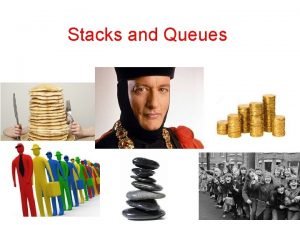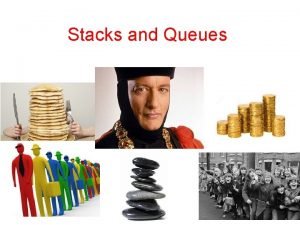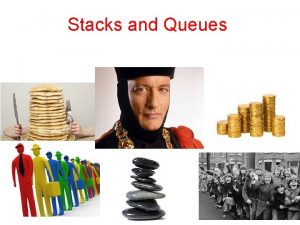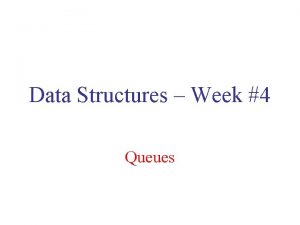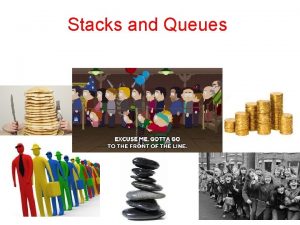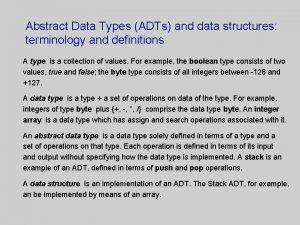Queues Chapter 8 Nyhoff ADTs Data Structures and
























- Slides: 24

Queues Chapter 8 Nyhoff, ADTs, Data Structures and Problem Solving with C++, Second Edition, © 2005 Pearson Education, Inc. All rights reserved. 0 -13 -140909 -3 1

Chapter Contents 8. 1 Introduction to Queues 8. 2 Designing and Building a Queue Class – Array Based 8. 3 Linked Queues 8. 4 Application of Queues: Buffers and Scheduling 8. 5 Case Study: Center Simulation Nyhoff, ADTs, Data Structures and Problem Solving with C++, Second Edition, © 2005 Pearson Education, Inc. All rights reserved. 0 -13 -140909 -3 2

Chapter Objectives • To study a queue as an ADT • Build a static-array-based implementation of queues • Build a dynamic-array-based implementation of queues • Show queues are used in I/O buffers and scheduling in a computer system • (Optional) See how queues are used in simulations of phenomena that involve waiting in lines Nyhoff, ADTs, Data Structures and Problem Solving with C++, Second Edition, © 2005 Pearson Education, Inc. All rights reserved. 0 -13 -140909 -3 3

Introduction to Queues • A queue is a waiting line – seen in daily life – A line of people waiting for a bank teller – A line of cars at a toll both – "This is the captain, we're 5 th in line for takeoff" • What other kinds of queues can you think of Nyhoff, ADTs, Data Structures and Problem Solving with C++, Second Edition, © 2005 Pearson Education, Inc. All rights reserved. 0 -13 -140909 -3 4

The Queue As an ADT • A queue is a sequence of data elements • In the sequence – Items can be removed only at the front – Items can be added only at the other end, the back • Basic operations – – – Construct a queue Check if empty Enqueue (add element to back) Front (retrieve value of element from front) Dequeue (remove element from front) Nyhoff, ADTs, Data Structures and Problem Solving with C++, Second Edition, © 2005 Pearson Education, Inc. All rights reserved. 0 -13 -140909 -3 5

Example: Drill and Practice Problems • We seek a program to present elementary math problems to students • They are presented with a problem where they combine randomly generated integers • When they respond are – Successful – proceed to another problem – Unsuccessful – problem stored for asking again later • The program will determine the number of problems and largest values used in the operation • Then it will generate that many problems and place them in the problem queue Nyhoff, ADTs, Data Structures and Problem Solving with C++, Second Edition, © 2005 Pearson Education, Inc. All rights reserved. 0 -13 -140909 -3 6

Example: Drill and Practice Problems • For now, we will assume a queue class • Note declaration of the Addition. Problem class, Fig 8. 1 A • Implementation, Addition. Problem. cpp, Fig 8. 1 B • View source code of drill and practice program, Fig. 8. 1 C Nyhoff, ADTs, Data Structures and Problem Solving with C++, Second Edition, © 2005 Pearson Education, Inc. All rights reserved. 0 -13 -140909 -3 7

Designing and Building a Queue Class Array-Based • Consider an array in which to store a queue • Note additional variables needed – my. Front, my. Back • Picture a queue object like this Nyhoff, ADTs, Data Structures and Problem Solving with C++, Second Edition, © 2005 Pearson Education, Inc. All rights reserved. 0 -13 -140909 -3 8

Designing and Building a Queue Class Array-Based • Problems – We quickly "walk off the end" of the array • Possible solutions – Shift array elements – Use a circular queue – Note that both empty and full queue gives my. Back == my. Front Nyhoff, ADTs, Data Structures and Problem Solving with C++, Second Edition, © 2005 Pearson Education, Inc. All rights reserved. 0 -13 -140909 -3 9

Designing and Building a Queue Class Array-Based • Using a static array – QUEUE_CAPACITY specified – Enqueue increments my. Back using mod operator, checks for full queue – Dequeue increments my. Front using mod operator, checks for empty queue • Note declaration of Queue class, Fig 8. 2 A • View implementation, Fig. 8. 2 B Nyhoff, ADTs, Data Structures and Problem Solving with C++, Second Edition, © 2005 Pearson Education, Inc. All rights reserved. 0 -13 -140909 -3 10

Using Dynamic Array to Store Queue Elements • Similar problems as with list and stack – Fixed size array can be specified too large or too small • Dynamic array design allows sizing of array for multiple situations • Results in structure as shown – my. Capacity determined at run time Nyhoff, ADTs, Data Structures and Problem Solving with C++, Second Edition, © 2005 Pearson Education, Inc. All rights reserved. 0 -13 -140909 -3 11

Linked Queues • Even with dynamic allocation of queue size – Array size is still fixed – Cannot be adjusted during run of program • Could use linked list to store queue elements – Can grow and shrink to fit the situation – No need for upper bound (my. Capacity) Nyhoff, ADTs, Data Structures and Problem Solving with C++, Second Edition, © 2005 Pearson Education, Inc. All rights reserved. 0 -13 -140909 -3 12

Linked Queues • Constructor initializes my. Front, my. Back • Front – return my. Front->data • Dequeue – Delete first node (watch for empty queue) • Enqueue – Insert node at end of list • View LQueue. h declaration, Fig 8. 3 A • Note definition, LQueue. cpp, Fig 8. 3 B • Driver program, Fig. 8. 3 C Nyhoff, ADTs, Data Structures and Problem Solving with C++, Second Edition, © 2005 Pearson Education, Inc. All rights reserved. 0 -13 -140909 -3 13

Circular Linked List • Possible to treat the linked list as circular – Last node points back to first node – Alternatively keep pointer to last node rather than first node Nyhoff, ADTs, Data Structures and Problem Solving with C++, Second Edition, © 2005 Pearson Education, Inc. All rights reserved. 0 -13 -140909 -3 14

Application of Queues: Buffers and Scheduling • Important use of queues is I/O scheduling – Use buffers in memory to improve program execution – Buffer arranged in FIFO structure Nyhoff, ADTs, Data Structures and Problem Solving with C++, Second Edition, © 2005 Pearson Education, Inc. All rights reserved. 0 -13 -140909 -3 15

Application of Queues: Buffers and Scheduling • Also times when insertions, deletions must be made from both ends – Consider a scrolling window on the screen • This requires a double ended queue – Called a deque (pronounced "deck") – Could also be considered a double ended stack (or "dack") Nyhoff, ADTs, Data Structures and Problem Solving with C++, Second Edition, © 2005 Pearson Education, Inc. All rights reserved. 0 -13 -140909 -3 16

Application of Queues: Buffers and Scheduling • Consider a keyboard buffer – Acts as a queue – But elements may be removed from the back of the queue with backspace key • A printer spool is a queue of print jobs Nyhoff, ADTs, Data Structures and Problem Solving with C++, Second Edition, © 2005 Pearson Education, Inc. All rights reserved. 0 -13 -140909 -3 17

Application of Queues: Buffers and Scheduling • Queues used to schedule tasks within an operating system • Job moves from disk to ready queue Nyhoff, ADTs, Data Structures and Problem Solving with C++, Second Edition, © 2005 Pearson Education, Inc. All rights reserved. 0 -13 -140909 -3 18

Application of Queues: Buffers and Scheduling • Ready queue may actually be a priority queue … job may get to "cut the line" based on its priority Nyhoff, ADTs, Data Structures and Problem Solving with C++, Second Edition, © 2005 Pearson Education, Inc. All rights reserved. 0 -13 -140909 -3 19

Case Study: Information Center Simulation • Most waiting lines (queues) are dynamic – Their lengths grow and shrink over time • Simulation models this dynamic process – Enables study of the behavior of the process – Modeled with one or more equations • Queue behavior involves randomness – We will us pseudorandom number generator Nyhoff, ADTs, Data Structures and Problem Solving with C++, Second Edition, © 2005 Pearson Education, Inc. All rights reserved. 0 -13 -140909 -3 20

Problem Analysis and Specification • Consider an information center – Calls arrive at random intervals – Placed in queue of incoming calls – When agent becomes available, services call at front of queue • We will simulate receipt of "calls" for some number of "minutes" – we keep track of calls in the queue Nyhoff, ADTs, Data Structures and Problem Solving with C++, Second Edition, © 2005 Pearson Education, Inc. All rights reserved. 0 -13 -140909 -3 21

Problem Analysis and Specification • Input to the simulation program – Time limit – Arrival rate of calls – Distribution of service times • Desired output – Number of calls processed – Average waiting time per call • Note declaration of Simulation class, Fig. 8 -4 Nyhoff, ADTs, Data Structures and Problem Solving with C++, Second Edition, © 2005 Pearson Education, Inc. All rights reserved. 0 -13 -140909 -3 22

Problem Analysis and Specification • Constructor – Initialize input data members – my. Timer, my. Incoming. Calls initialized by their constructors • The run() method – Starts and manages simulation • The check. For. New. Call() method – Random number generated, compared to my. Arrival. Rate – If new call has arrived, create new Call object, place in queue Nyhoff, ADTs, Data Structures and Problem Solving with C++, Second Edition, © 2005 Pearson Education, Inc. All rights reserved. 0 -13 -140909 -3 23

Problem Analysis and Specification • The service() method – Checks time remaining for current call – When done, retrieves and starts up next call from front of queue • The display() method – Report generated at end of simulation • View definition of function members Fig. 8 -5 A • Note driver program for simulation, Fig. 8 -5 B • Reference the Timer class and Call class used in the Simulation class Nyhoff, ADTs, Data Structures and Problem Solving with C++, Second Edition, © 2005 Pearson Education, Inc. All rights reserved. 0 -13 -140909 -3 24
 Adts, data structures, and problem solving with c++
Adts, data structures, and problem solving with c++ Parameterized adts is also known as
Parameterized adts is also known as Parameterized adts is also known as
Parameterized adts is also known as Adts ukiah
Adts ukiah Queue adalah jenis antrian
Queue adalah jenis antrian Cqueue
Cqueue Java stacks and queues
Java stacks and queues Java stack exercises
Java stack exercises Java stacks and queues
Java stacks and queues Queue quiz
Queue quiz Representation of queues
Representation of queues Message queue in unix
Message queue in unix Adaptable priority queue
Adaptable priority queue Pipes in rtos
Pipes in rtos Applications of priority queues
Applications of priority queues Define a queue
Define a queue Erisone queues
Erisone queues Homologous structure
Homologous structure Data structures chapter 1
Data structures chapter 1 Professor ajit diwan
Professor ajit diwan Amit agarwal princeton
Amit agarwal princeton Data structures and algorithms tutorial
Data structures and algorithms tutorial Conditional macro expansion in system software
Conditional macro expansion in system software Assembler data structures
Assembler data structures Information retrieval data structures and algorithms
Information retrieval data structures and algorithms

